Mad Hedge Technology Letter
February 25, 2022
Fiat Lux
Featured Trade:
(BULLISH TAILWINDS DEFEND THE NASDAQ)
($COMPQ)

Mad Hedge Technology Letter
February 25, 2022
Fiat Lux
Featured Trade:
(BULLISH TAILWINDS DEFEND THE NASDAQ)
($COMPQ)

The 6.5% reversal in the Nasdaq has been as V-shaped as can be.
Let me remind readers that this Ukraine war is just only one external factor the market is trying to stomach.
It’s not the only show in town.
As we zero in on the March Fed Meeting that comes into focus, I would argue unless new developments rear their ugly head, the Ukraine-Russia hot war is what it is which is mostly quantified.
The Nasdaq index was cheering the light sanctions as the West chose to avoid the nuclear option of removing Russia from accessing the SWIFT system of global bank payments.
Germany refuses to support this option as it would make it harder to pay the Russians for their oil and natural gas.
America also doesn’t support this because we have concerns that it would undermine the status of the U.S. dollar as the global reserve currency.
On more of a micro level, the Ukraine-Russia situation mostly affects energy and food prices which is a relative win for the Nasdaq index that is comprised of technology.
The Nasdaq has outperformed the Dow and S&P in this short quick spike to the upside contributing to my thesis of investors feeling more comfortable dollar-cost averaging into the best breed of tech than reaching for something more inferior.
And yes, I am saying the best companies currently listed in America are tech companies.
The geopolitical turmoil overshooting means that the Nasdaq index is now pricing in a 25-basis point cut instead of a 50-basis point cut.
Either case is still highly stimulatory, and the Fed is way behind the curve on inflation, and this does mean that inflation will stick around a lot longer than first anticipated.
According to the Federal Reserve Economic Data (FRED), the US Central Bank has actually been increasing asset purchases to their balance sheet most likely because they are becoming nervous about the transition from dovish to hawkish policy.
To add an inflationary pillow to the interest rate dilemma is irresponsible, but it shows investors how much pressure is on the Fed to get this right after waiting way too long to raise rates.
Ultimately, I believe the Fed is also concerned about the recent selloff and these asset purchases will ensure the market does not dip to painful levels.
Traders got wind of the green lighting of saving the stock market and piled into risk-on assets and this reversal does a lot to draw a line in the sand as to what level of volatility the Fed is able or willing to tolerate.
Boosting the balance sheet to new all-time highs means that the Fed will need to be careful because nobody really knows how much they can push the hawkishness with a $9 trillion debt load.
It seems counterintuitive to initiate new asset purchases at these levels, and this behavior implicitly admits that the Fed cares more about saving the stock market by reducing volatility than putting a kibosh on hyperinflation.
Basically, high inflation is here to stay.
The $9 trillion Central Bank balance sheet is 43% of the United States’ GDP and it appears that the Fed is taking the Japan approach to their balance sheet.
Of course, there is nothing illegal about government asset purchases, just look at Japan whose Central Bank owns about 15% of the Japanese stock market and the US Fed is using their playbook as they look to future decisions on monetary policy.
Will it get to that point of a Japanese monetary policy?
Desperate times call for desperate measures.
If the Fed governor Jerome Powell does go insane with liberal infusions of asset purchases, then readers can bet that tech stocks will be the first to benefit from fresh liquidity.
Does it appear that the U.S. Central Bank is trigger happy when any crisis comes along?
There are elements of truth to that, but we aren’t the ones making the decisions, and on the next mini dip, I would use that as a new entry point into the best American tech stocks on the planet such as the likes of Alphabet (GOOLG), Adobe (ADBE), Microsoft (MSFT), and Apple (AAPL).
Lastly, we are exploding from the embers of the omicron virus and that hasn’t gotten much play because of the war reports.
Once these pandemic headwinds are thrown to the side, the U.S. economy and technology companies will accelerate into the summer.
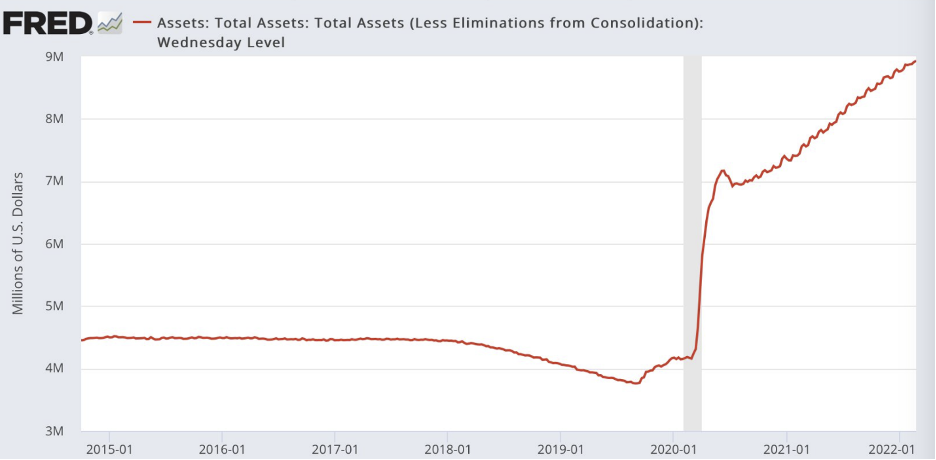
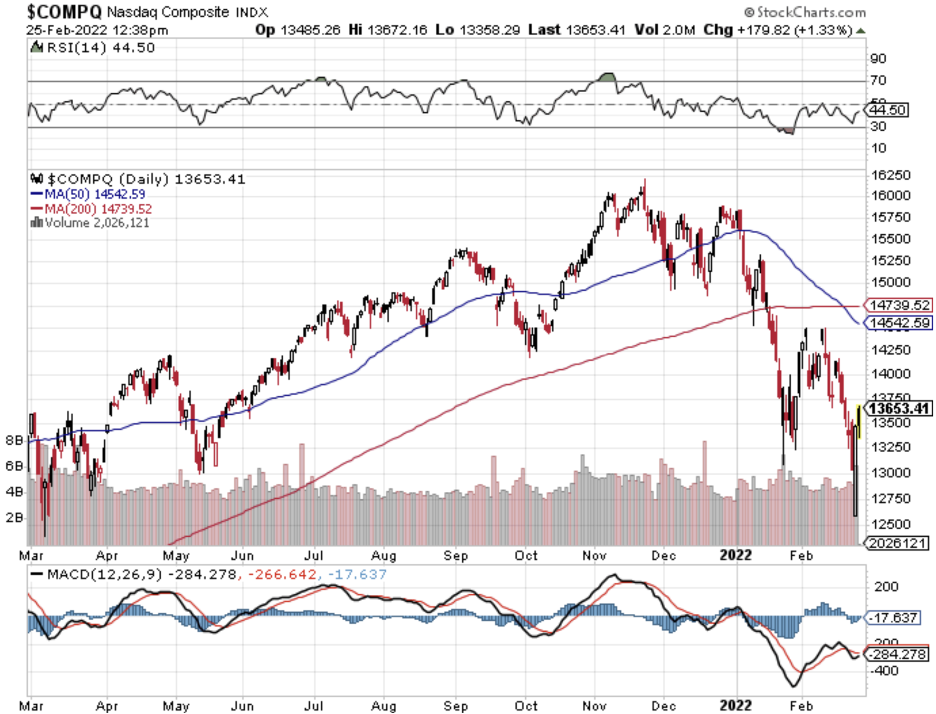
Mad Hedge Technology Letter
February 23, 2022
Fiat Lux
Featured Trade:
(5 TIPS TO HELP NAVIGATE THE TECH MARKET CORRECTION)
($COMPQ)

The Nasdaq technology index has been on a bull run for the ages.
You didn’t think it was going to last forever, did you?
In the past 10 years, we’ve only had three little blips, one in 2019 from the temper tantrum, then the 2020 pandemic selloff, and now the 2022 inflation problem.
It’s more or less been strong performance aside from those quick corrections where the Nasdaq bounced back even stronger.
The truth is that meaningful corrections don’t happen that often and every time one has occurred, it’s been a great buying opportunity.
I know it sounds scary in the face of red drowning out your screen, but the silver lining is that this will give readers a chance to grab high quality stocks that are rarely, if at all, on sale.
Here are a few tips on how to navigate a tech market correction.
Since 1928, a correction of at least 10% has happened about once every 19 months – not that often. Of the 27 corrections since World War II, the index has experienced an average decline of 13.7%.
This highlights the simple truth that investing is not a contest of who can dump stocks as fast as possible.
If you’re convinced a sell-off is on the horizon, consider making the following changes.
Sell stocks in your portfolio that you think have peaked.
Alternatively, you may want to establish a selling strategy that dictates when you sell stocks and remove any emotion from the decision.
This type of strategy is a method of managing stress and you will avoid misusing that fat finger to get rid of your best assets.
Preside over a healthy mix of different types of investments that will hold their value until you can jump back into tech stocks.
Don’t put all your money into Facebook (FB) and feel wounded after it drops 25% after their business model collapses (which is essentially what just happened.)
Rarely will everything go down all at once.
The tech sector usually experiences more downside in a correction than others due to their high growth nature.
This is when dividend-paying stocks start to outperform and a huge rotation rapidly takes place.
It is essential to always place limit orders and not market orders. With a limit order, you specify the price you want to buy or sell at, and the trade is only executed at that price or better.
Meanwhile, opting for a market order means your trade is at the whim of the market. The final filled order could be a few percentage points of where you expected it.
This nasty surprise is easy to avoid.
Even if you’re a buy-and-hold investor, you’ll eventually want to sell some of your investments.
Minimizing risks is the name of the game and most investors have a number in mind at the end of the day.
This number is complemented by a timeline; don’t lose sight of the path towards that, and the process needed to achieve that final number.
Markets almost never sell off by 20% and many of these market corrections are great chances to get into the best of tech.
Let’s be honest, tech has been very expensive the last few years and to get a great company like Google, Apple, or Microsoft on discount is something that people pray for.
The tech market has always recovered from its short- and longer-term market dips and this correction won’t be any different.

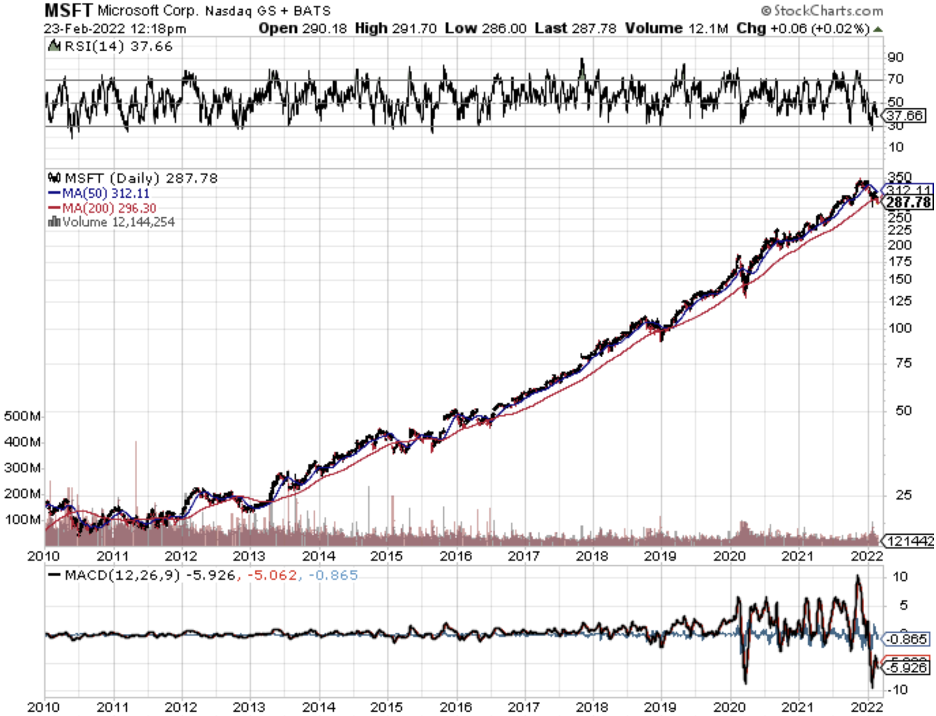
Global Market Comments
December 8, 2021
Fiat Lux
Featured Trade:
(ON EXECUTING MY TRADE ALERTS),
(TEN REASONS WHY STOCKS CAN’T SELL OFF BIG TIME),
(SPY), (INDU), ($COMPQ), (IWM), (TLT), (GME)
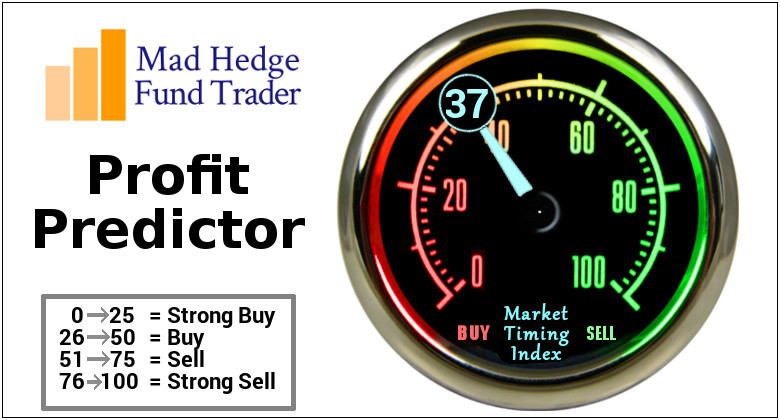
Global Market Comments
February 9, 2021
Fiat Lux
Featured Trade:
(ON EXECUTING MY TRADE ALERTS),
(TEN REASONS WHY STOCKS CAN’T SELL OFF BIG TIME),
(SPY), (INDU), ($COMPQ), (IWM), (TLT), (GME)

Mad Hedge Technology Letter
October 26, 2020
Fiat Lux
Featured Trade:
(WHAT DOES DIGITAL UPSKILLING MEAN TO TECH?)
(AAPL), ($COMPQ)

The signals are there offering the impetus to the U.S. workforce to become increasingly tech-savvy in a hurry.
A word was even coined for it: “Digital upskilling.”
The idea of this development in digital skills is, in fact, the reason why every investor needs to look at tech growth stocks as the cornerstone of their investment portfolio.
To understand the trajectory of tech growth stocks, analyzing the entry level of industry employment offers a clearer snapshot of the meat and bones of the industry.
The tech workforce is upskilling precisely because they are incentivized with the opportunity to secure higher salaries.
The higher salaries exist precisely because tech corporations can afford to pay their workers more when they participate in a business cycle that delivers 40% higher revenue than the year before.
It’s a virtuous cycle that not only enriches the shareholder but is a golden chance for U.S. workers to secure a high-quality life when other U.S. industries like retail, hospitality, and energy have crashed and burned.
The very day that tech companies stop doling out larger than life salaries will be the cue that we are at ex-growth and investors must be able to pivot quickly to target the next growth part of the economy.
The great x-factor of technology is that there will always be a new start-up tech reshaping the industry and old technologies just become obsolete like the fax machine and Atari game console.
Therefore, the upskilling at all levels of the tech ladder means the possibility that someone will strike it rich by discovering a new technology that is able to revolutionize the industry.
Companies are even offering in-company courses to encourage employees to hone their skills.
This can often lead to exciting promotions even in a time where the economy has been throttled to a standstill.
The latest accelerator has been none other than the coronavirus as corporations have been forced to continue operations without the help of a physical office.
Corporations are fast-tracking their embrace of digital technologies and enabling workers to learn wherever they are, whenever they want, on any device.
Around 86% of top-performing companies reported that digital training programs boosted employee engagement and performance.
The aim of tech companies is to load itself with employees skilled in data science, data storage technology skills, tech support, and digital literacy.
Other marketable skills include software development, digital marketing, and IT administration.
The real hurdle in digital upskilling lies in execution, making an entire workforce digitally savvy is a tough chore and there will always be stragglers bringing up the rear.
Corporates have ploughed full steam into upskilling and even though Silicon Valley hasn’t moved on from the smartphone, it is squeezing as much juice from this grapefruit as it can.
We are now onto the Apple (AAPL) iPhone 12 and who knows, we might get to the iPhone 20 or 30.
We are onto the Apple iPhone 12 because it’s a cash cow and that won’t stop which is why investors need to feed their appetite for premium US tech stocks.
Stocks are divided into “value” and “growth” halves. The former consists of the stocks that are cheapest in relation to net assets, current cash flow, and so on. These tend to be older, duller, and less exciting companies.
The other half, “growth,” tends to consist of the glamorous companies that have monopolies.
Just look at the performance of value stocks. The average U.S. large company “value” mutual fund has lost 8% so far this year, even including reinvested dividends.
The average growth fund? It’s up a stunning 30%. And this gap has been going on for years: “Growth” funds have beaten “Value” funds since as far back as 2007, market data show.
From the upskilling at entry-level jobs, there are signs everywhere that investing in high growth tech is the way to go and if you compare tech to the rest of the market in 2020, the numbers are a no-brainer.

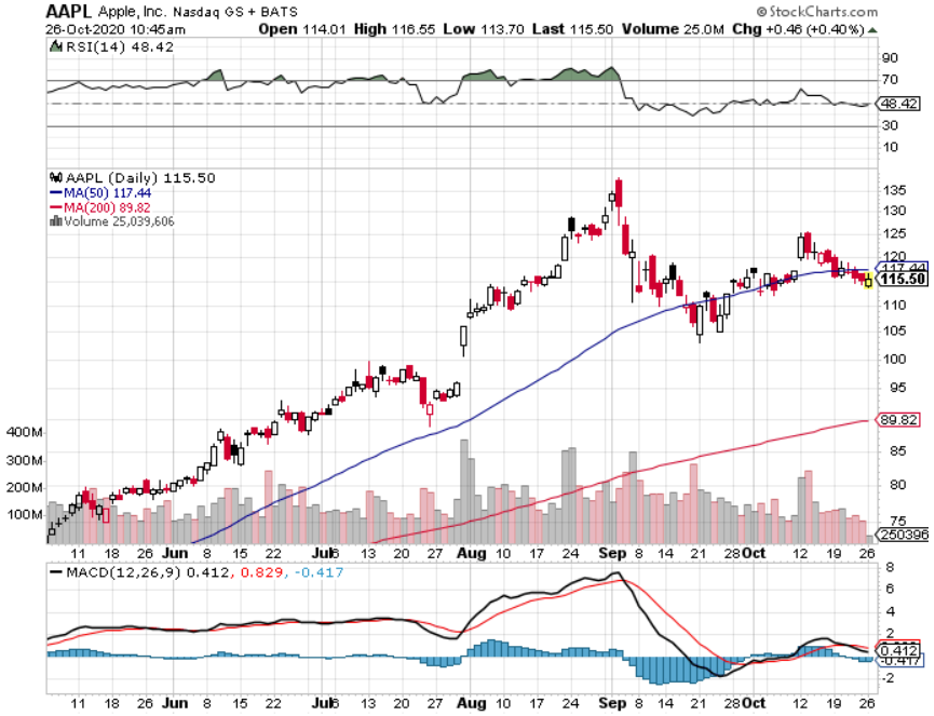
Mad Hedge Technology Letter
October 14, 2020
Fiat Lux
Featured Trade:
(TECH OPTION VOLUME UNHINGED)
($COMPQ), (APPL), (FB), (MSFT), (GOOGL), (NFLX)
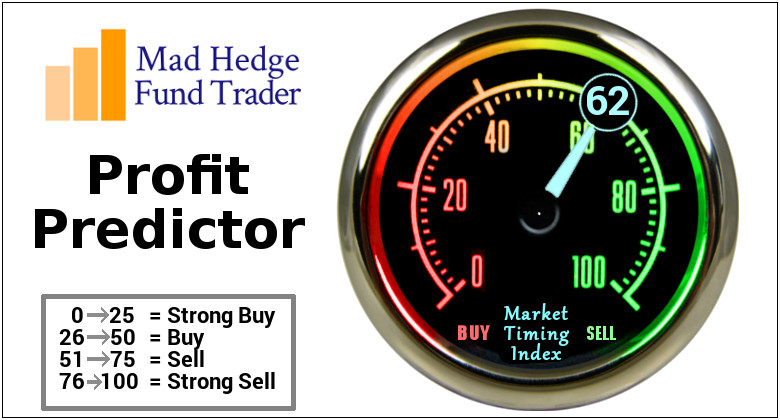
The euphoria in big cap tech shares is the catalyst moving the Nasdaq index recently.
Call option activity is taking the top off of tech shares with usual low beta stocks surging over 5% in single trading sessions.
This unfortunately is causing our options trades to experience heightened stock volatility and the knock-on effect is our strikes getting blown out.
Some of the excess volatility comes down to traders making big bets in the run-up to the election.
Remember when Trump won in 2016, the market exploded higher when many “experts” guaranteed a massive sell-off would ensue.
In the short-term, the unsustainable pace of speculation in derivatives will translate into wild price swings. Monday brought the biggest rally for the Nasdaq 100 Index since April, but measures of volatility rallied as well.
One proxy for the froth still latent in options, the percentage of overall volume represented by single-stock contracts, remains up 19% from a year ago.
Most of the action is concentrated in mega cap technology and momentum-driven shares.
A consensus is coalescing around a few big buyers coming into the options market to corner it with rumors of purchases around $300 million worth of call contracts on tech stocks in a single day.
The Nasdaq 100 Index has gained in all but two sessions this month and just notched its best week since July after last month’s sharp drop.
Whipsawing markets are also possible when liquidity remains thin.
Trading in options showed itself capable of influencing share movement in August and September when dealer hedging (demand from people who sell options for the underlying stock) created feedback loops that helped drive the Nasdaq higher.
That dynamic can also make sell-offs worse than they should be as well as sellers adjust positions.
Big trades in thin markets, especially in technology or momentum trades considered overbought or oversold, increase the potential for exacerbated stock moves as dealers hedge exposure.
Call open interest in Facebook (FB), Amazon (AMZN), Netflix (NFLX), Alphabet (GOOGL), Apple (APPL) and Microsoft (MSFT) has averaged 12.8 million contracts over the 30 days through Friday, the highest since early 2019.
The tech-heavy Nasdaq index has gyrated an average of 1.8% per day since the beginning of September, while the broader market gauge has fluctuated by 1.2% over that time period.
Recent options activity has been momentum-based, meaning that stocks tend to attract more interest in calls when it’s rallying versus when it trades lower.
Throw in structural forces that are contributing to a sustained high implied volatility environment, and election hedgers have their work cut out for them.
There are fewer short-volatility players as well in the wake of the health crisis.
There’s also less volatility selling by retail investors after the delisting of some popular VIX products earlier this year like the volatility ETF ticker symbol XIV.
It could take a few years for the imbalances to work itself through the system.
Then there’s the resurfacing of an event similar to the “Nasdaq whale” which is reported as Softbank acting like a hedge fund and buying as many big tech call options they could afford.
Softbank CEO has essentially turned his failed hedge fund named the Vision Fund from a start-up investor into a speculative hedge fund in risky option contracts solely betting on the rise of Silicon Valley tech in the age of the coronavirus.
After being burnt by Uber and WeWork, he finally decided to stay out of the messy acquisitions/seed funding and just speculative through derivatives from Tokyo.
The avalanche of options volume will no doubt cause the tech markets to become jittery and it certainly puts a floor under tech implied volatility for a while.
Retail investors have taken notice of this insane volume and largely stayed on the sideline.
At the apex of the madness, retail traders spent more than $511 billion in notional value on call options and that figure was slashed to $343 billion in the first week of October.
Retail traders tend to buy less-expensive short-dated contracts which tend to have greater convexity and ability to exacerbate share movements.
The level of risk-taking occurring in the public markets is at an all-time high.
Just look at America’s most elite university endowments who have slashed their exposure to the stock markets to the lowest levels since before the crash of 1929. And now they’re betting the ranch on secretive, illiquid, and high-risk private-equity funds and hedge funds.
A US teachers’ pension fund has sued Allianz Global Investors, accusing one of the world’s biggest asset managers of employing a “reckless strategy” that cost retirees almost $800m during this year’s market turmoil.
This is just one example of the high-risk strategies taking place with pension money.
In a lawsuit filed on Monday in New York, the Arkansas Teacher Retirement System claims that Alpha Funds, investment vehicles marketed by AllianzGI, had placed bets against an escalation of market volatility in an effort to recover losses they incurred from the same strategy in February.
So here we stand with derivative trading in tech options and general equity strategies leveraged to the hills that are betting on the system not breaking, or at least not breaking yet.
Even if the system reaches breaking point, many of these private investors are betting on governments to come rescue them perpetuating the feedback loop and offers a conundrum to savvy asset managers to miss or partake in the gaps up themselves.

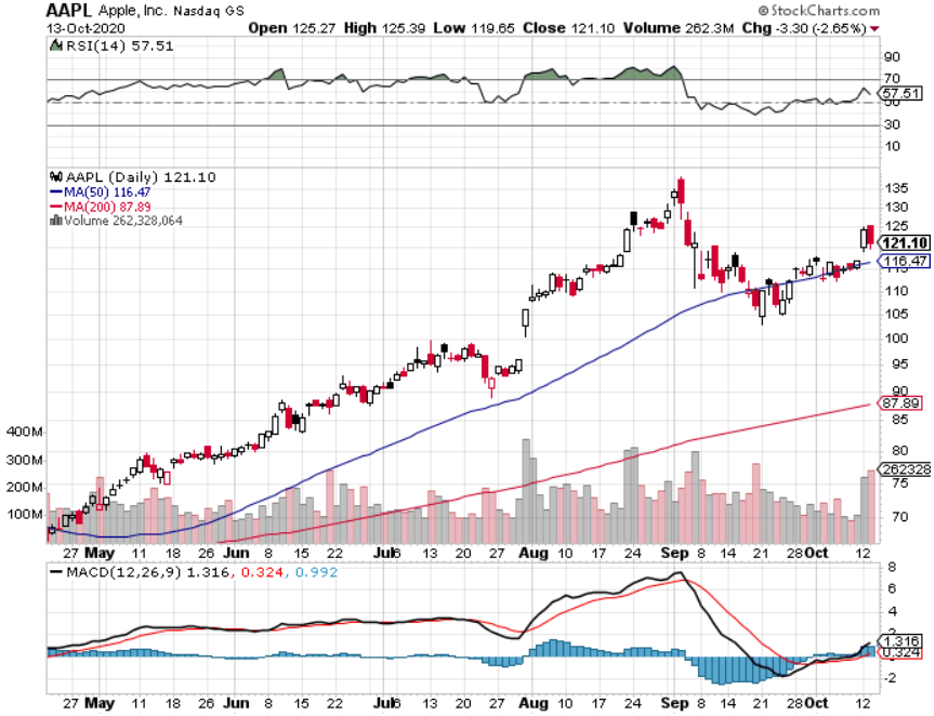
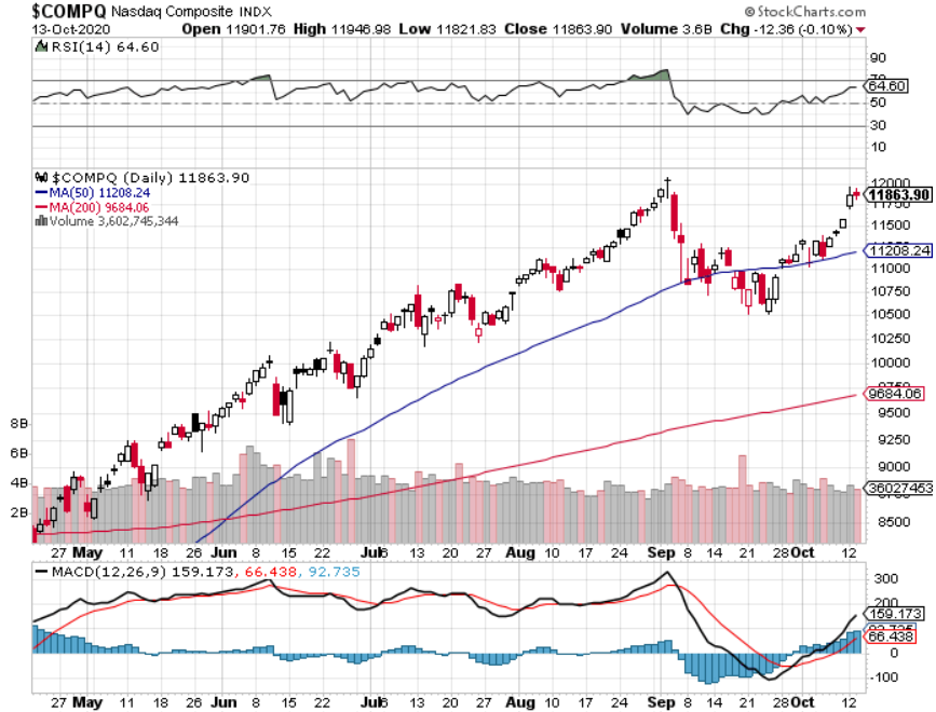
Legal Disclaimer
There is a very high degree of risk involved in trading. Past results are not indicative of future returns. MadHedgeFundTrader.com and all individuals affiliated with this site assume no responsibilities for your trading and investment results. The indicators, strategies, columns, articles and all other features are for educational purposes only and should not be construed as investment advice. Information for futures trading observations are obtained from sources believed to be reliable, but we do not warrant its completeness or accuracy, or warrant any results from the use of the information. Your use of the trading observations is entirely at your own risk and it is your sole responsibility to evaluate the accuracy, completeness and usefulness of the information. You must assess the risk of any trade with your broker and make your own independent decisions regarding any securities mentioned herein. Affiliates of MadHedgeFundTrader.com may have a position or effect transactions in the securities described herein (or options thereon) and/or otherwise employ trading strategies that may be consistent or inconsistent with the provided strategies.
This site uses cookies. By continuing to browse the site, you are agreeing to our use of cookies.
OKLearn moreWe may request cookies to be set on your device. We use cookies to let us know when you visit our websites, how you interact with us, to enrich your user experience, and to customize your relationship with our website.
Click on the different category headings to find out more. You can also change some of your preferences. Note that blocking some types of cookies may impact your experience on our websites and the services we are able to offer.
These cookies are strictly necessary to provide you with services available through our website and to use some of its features.
Because these cookies are strictly necessary to deliver the website, refuseing them will have impact how our site functions. You always can block or delete cookies by changing your browser settings and force blocking all cookies on this website. But this will always prompt you to accept/refuse cookies when revisiting our site.
We fully respect if you want to refuse cookies but to avoid asking you again and again kindly allow us to store a cookie for that. You are free to opt out any time or opt in for other cookies to get a better experience. If you refuse cookies we will remove all set cookies in our domain.
We provide you with a list of stored cookies on your computer in our domain so you can check what we stored. Due to security reasons we are not able to show or modify cookies from other domains. You can check these in your browser security settings.
These cookies collect information that is used either in aggregate form to help us understand how our website is being used or how effective our marketing campaigns are, or to help us customize our website and application for you in order to enhance your experience.
If you do not want that we track your visist to our site you can disable tracking in your browser here:
We also use different external services like Google Webfonts, Google Maps, and external Video providers. Since these providers may collect personal data like your IP address we allow you to block them here. Please be aware that this might heavily reduce the functionality and appearance of our site. Changes will take effect once you reload the page.
Google Webfont Settings:
Google Map Settings:
Vimeo and Youtube video embeds:
